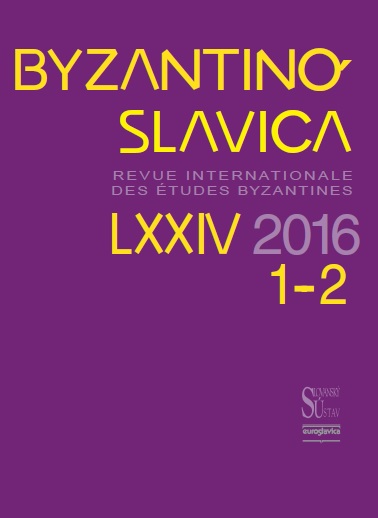‘Byzantis’ as a Movable Quality: Carrying Constantinople Into the Frontier Provinces in the 10th – 11th Centuries
‘Byzantis’ as a Movable Quality: Carrying Constantinople Into the Frontier Provinces in the 10th – 11th Centuries
Author(s): AnnaLinden WellerSubject(s): History, Language and Literature Studies
Published by: AV ČR - Akademie věd České republiky - Slovanský ústav and Euroslavica
Keywords: Constantinople;corespondence;Philetos Synadenos;Nikephoros Ouranos;Hodoiporikon
Summary/Abstract: This article considers the quality of ‘Byzantis’ – “Constantinopolitan-ness” – as a trait, which accompanies particular Byzantines who journey outside of the imperial capital and into the liminal or frontier spaces of Byzantium. The word itself is a middle/late Byzantine form of the toponymic adjective byzantios, which appears as early as Thucydides to describe an inhabitant of Constantinople (former Byzantion). This form, which has acquired connotations of being Constantinopolitan (as an attitude or mode of life) as well as being from Constantinople, becomes commonly employed in the 10th and 11th centuries, when not used precisely to refer to someone’s origins, to contrast the Constantinopolitan with the non-Constantinopolitan – Rhomaioi with barbaroi. Those individuals who are able to carry Byzantis with them despite being absent from Constantinople itself render the inhospitable landscapes through which they travel suddenly hospitable again. The article presents two case studies and some further corroborating data from word frequency analysis performed with the Thesaurus Linguae Graecae. The fi rst case study appears in the early 11th century correspondence of Philetos Synadenos, krites of Tarsus, and Nikephoros Ouranos, doux of Antioch. Synadenos claims that Ouranos’s possession of Byzantis is what makes Antioch a bastion of Byzantine culture despite being on the far edge of the empire. The second case study discusses the Hodoiporikon of Constantine Manasses. In this text, Manasses reported on his journey in the company of the sebastos John Kontostephanos through Asia Minor on a political mission, which eventually goes awry, trapping Manasses alone without the sebastos in Cyprus. Isolated, Manasses succumbed to illness, homesickness, and cultural loneliness. This illness and depression is relieved when the sebastos returned to Manasses’ company. The sebastos – a fellow Constantinopolitan – had, in essence, brought Constantinople to him via his presence.
Journal: Byzantinoslavica - Revue internationale des Etudes Byzantines
- Issue Year: LXXIV/2016
- Issue No: 1-2
- Page Range: 190-201
- Page Count: 12
- Language: English
- Content File-PDF

